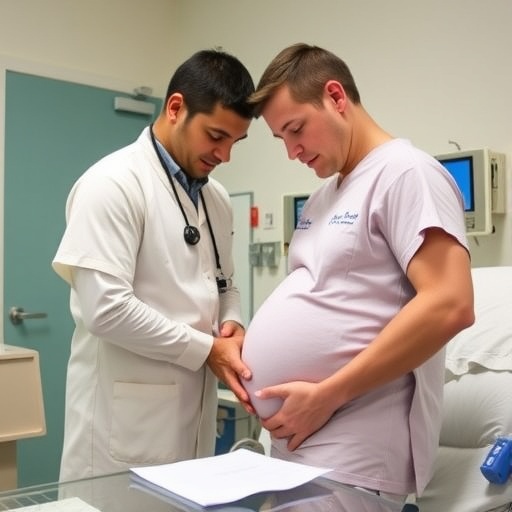
In the rapidly evolving field of genome editing, precision remains the cornerstone for advancing therapeutic potentials and broadening biological understanding. Among the myriad of tools developed, base editors (BEs) have emerged as transformative agents in enabling targeted nucleotide conversions without inducing double-strand breaks. While cytosine base editors (CBEs) and adenine base editors (ABEs) have reshaped the genome editing landscape by mediating C:G to T:A and A:T to G:C conversions respectively, their intrinsic lack of nucleotide context discrimination within the editing window poses substantial challenges to precision and safety. A groundbreaking study by Wu, Xiao, and Tang published in Nature Biotechnology in 2025 addresses this pivotal limitation by evolving nucleic-acid-recognition hotspots within the Escherichia coli transfer RNA-specific adenosine deaminase (TadA), offering an elegant solution for nucleotide- and context-specific cytosine editing.
At its core, the innovation pivots on engineering TadA, a naturally adenine-specific deaminase, to gain the unprecedented ability to selectively target cytosines within dictated sequence contexts. This strategic reengineering marks a paradigm shift because traditional CBEs indiscriminately modify all cytosines within their editing window, leading to off-target mutations and broadened mutagenesis that complicates downstream applications in research and clinical therapies. By honing in on specific adjacent nucleotides flanking the cytosine of interest, the researchers afforded an unprecedented level of control, allowing the dissection of nucleotide context effects on editing specificity and efficiency.
The methodology harnessed directed evolution, a powerful strategy that mimics natural selection to generate protein variants with desired properties. Through iterative rounds of mutagenesis and selection, the team sampled multiple nucleic-acid recognition hotspots within TadA, sculpting its binding and catalytic interface to recognize and act upon cytosines with precise sequence context – effectively evolving sixteen TadA-derived NᴄN-specific deaminases. Each variant was tailored to unique −1 and +1 neighbor nucleotide contexts around the cytosine, thus offering an extensive toolbox that spans the entire sequence spectrum adjacent to the target base.
.adsslot_AfwEuvGYJX{width:728px !important;height:90px !important;}
@media(max-width:1199px){ .adsslot_AfwEuvGYJX{width:468px !important;height:60px !important;}
}
@media(max-width:767px){ .adsslot_AfwEuvGYJX{width:320px !important;height:50px !important;}
}
ADVERTISEMENT
This meticulous customization framework empowers researchers and clinicians to design bespoke base editors with nucleotide and context specificity, which is particularly critical when precise genetic corrections are warranted. The potential ramifications for treating monogenic diseases caused by point mutations are immense, as faulty base editing at bystander cytosines has historically compromised therapeutic index and safety. By effectively “pinpoint editing,” the evolved TadA variants transcend previous limitations and bridge the gap toward clinical-grade precision.
The team demonstrated the practical utility of these evolved BEs in two major avenues. First, they targeted disease-associated T:A-to-C:G transition mutations cataloged in ClinVar, the publicly accessible archive housing clinically relevant genetic variations. Impressively, their approach surpassed conventional CBEs in accuracy in over 81.5% of tested cases. This improved precision could drastically reduce off-target consequences and make gene correction safer for therapeutic interventions. The ability to selectively target pathogenic alleles without collateral cytosine modifications marks a critical step forward for patient-tailored genome surgery.
Secondly, the study deployed these refined editors to model oncogenic mutations in vitro, accurately recreating two prominent cancer-driver mutations: the KRAS G12D mutation (characterized by an adenine to cytosine replacement in the sequence AᴄC) and the TP53 R248Q mutation (occurring within the cytosine-cytosine-guanine, CᴄG, context). Accurate modeling of such driver mutations facilitates the study of oncogenesis mechanisms, drug resistance, and therapeutic vulnerabilities. Base editors with these specificity profiles overcome prior hurdles where editing windows were too broad or nonspecific, thus muddying genotype-phenotype associations.
The underpinning biochemical innovation rests in leveraging the inherent substrate recognition and catalytic framework encoded in TadA and strategically remodeling it to change substrate preference from adenines to cytosines. This substrate reactivity switch, coupled with context selectivity, suggests an intimate link between nucleobase identity, neighboring nucleotide sequence, and enzyme active site dynamics. Such insights into the molecular recognition principles reveal fresh vistas in enzyme engineering beyond base editing, potentially influencing RNA editing and epigenetic modulation strategies.
Importantly, the evolved editors retain the modular fusion architecture with nuclease-deficient CRISPR proteins, preserving the programmability and targeting versatility characteristic of CRISPR-based platforms. This ensures the new generation of base editors can be seamlessly integrated into existing genome editing workflows, including delivery via viral vectors or ribonucleoprotein complexes, scaling from in vitro modeling to potential in vivo therapeutic applications.
The breadth of sequence contexts covered by the sixteen TadA-derived deaminases is unprecedented, furnishing an on-demand palette of editors tailored to any target cytosine considering its flanking nucleotides. Given the critical role of editing window context in off-target rates and efficiency, this level of granularity equips researchers with hyper-tailored tools, minimizing collateral damage and enhancing predictability—a pressing need in therapeutic editing scenarios.
From a clinical perspective, the prospect of correcting single-nucleotide variants with such precision addresses a vast array of genetic disorders that remain intractable due to editing inaccuracies. By reducing off-target deamination, the evolved BEs substantially mitigate risks such as undesired mutagenesis and immune responses triggered by unintentional edits, bolstering the overall safety profiles necessary for regulatory approvals and eventual human trials.
Furthermore, model systems enabled by these high-precision base editors promise to accelerate drug discovery pipelines by faithfully recapitulating pathogenic alleles and testing candidate compounds in genetically accurate contexts. This will improve the translational relevance of preclinical models, uncover novel genotype-specific drug responses, and elucidate mechanisms of disease resistance to precision medicine.
The implications extend beyond traditional gene therapy into synthetic biology and functional genomics. The ability to selectively manipulate individual nucleotides within native chromatin landscapes catalyzes new experimental designs investigating gene regulation, epistatic interactions, and evolutionary dynamics. Fine-tuning the editing landscape at a nucleotide level empowers researchers to dissect complex genetic networks with unparalleled resolution.
In sum, Wu, Xiao, and Tang’s study exemplifies how marrying protein engineering with CRISPR technology continues to push the boundaries of genome editing precision. By evolving TadA to achieve nucleotide context specificity for cytosine editing, they not only surmount a long-standing hurdle in base editing technology but also lay down a robust platform for developing next-generation therapies and research tools.
Future directions will likely explore amalgamating these evolved deaminases with further engineered Cas proteins bearing enhanced targeting scopes or reduced off-target cleavage, expanding the base editor toolkit’s versatility. Combining multiple evolved BEs could also enable multiplexed and combinatorial editing strategies tailored to complex genotypes and polygenic diseases.
As precision genome editing inches closer to clinical reality, studies like this are pivotal in surmounting molecular specificity challenges, thereby ensuring safer and more effective gene therapies. The strategic evolution of substrate selectivity within enzymatic effectors foreshadows a new era where personalized base editing interventions, attuned to individual genomic contexts, become feasible and routine.
Subject of Research: Development of highly precise cytosine base editors through engineering nucleic-acid-recognition specificity in TadA deaminase.
Article Title: High-precision cytosine base editors by evolving nucleic-acid-recognition hotspots in deaminase.
Article References:
Wu, Y., Xiao, YL. & Tang, W. High-precision cytosine base editors by evolving nucleic-acid-recognition hotspots in deaminase. Nat Biotechnol (2025). https://doi.org/10.1038/s41587-025-02678-w
Image Credits: AI Generated
Tags: adenine base editorscytosine base editorsdeaminase engineeringEscherichia coli TadAgenome editing technologiesinnovative genome editing solutionsmutagenesis in genetic researchnucleotide context discriminationoff-target mutations in genome editingprecision gene editingtargeted nucleotide conversionstherapeutic applications of base editing





